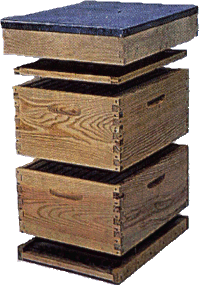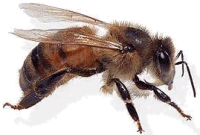THE BEEHIVE
The is the beekeeper's idea of how to keep the bees in a controlled environment where they can produce the maximum amount of for human use.
There are many different designs of hive in use throughout the world, although they all work on the same general principles, they have removable frames each a "bee space" away from the next frame.
World-wide there are many different designs of hive, but the two used most commonly in Britain are the WBC and the National, because the frames are interchangeable. WBC stands for William Broughton Carr, a famous beekeeper who invented this traditional style of hive at the turn of the last century.
The National works on the same principle as the WBC but does not have its characteristic outer walls. The Langstroth and Smith are other types of popular hives using different size components, though they work on the same principles.
The most commonly used hive in America and Australia is either the Dadant or the Langstroth

The main components of the man-made beehive are, from the ground up:
- Blocks to raise the hive from the ground to prevent damp;
- A floor which forms the base of the hive and contains the bees' front door entrance;
- A brood box, which is the main year-round home for the bee colony;
- A metal grille called a queen excluder which fits on top of the brood box to keep the queen in;
- A super (meaning "on top of") which is the food or honey store for the bees;
- Commercially made sheets of wax called foundation, which fit into removable wooden frames inside the brood box and super. This encourages the bees to make honeycomb;
- A crown board which may have a hole in it through which the bees may be fed;
- A roof, to keep the weather out and give the bees a nice, snug home.
